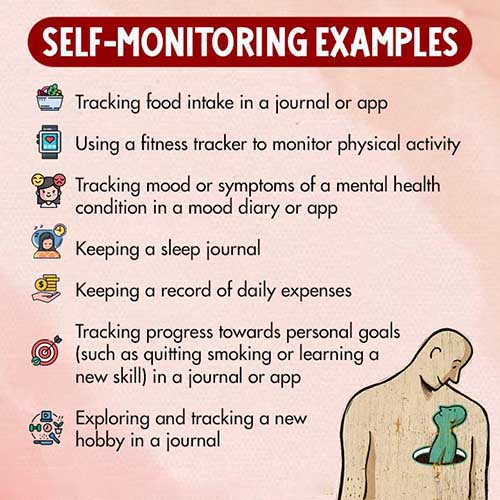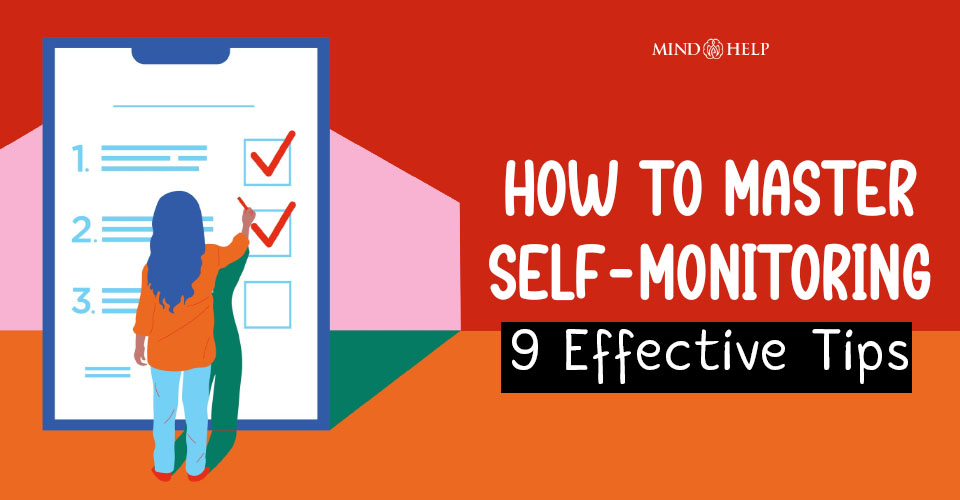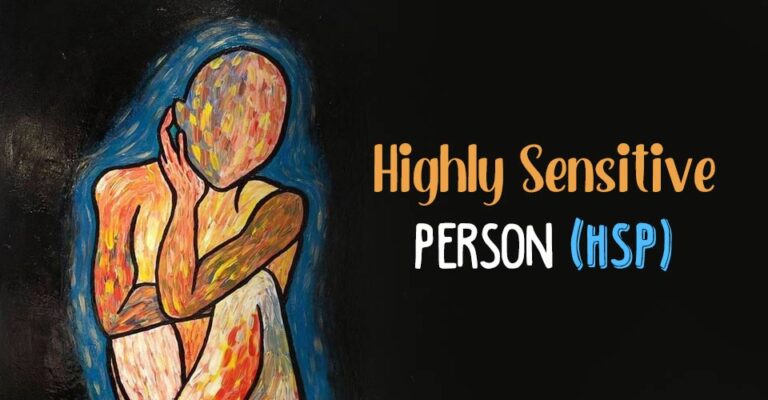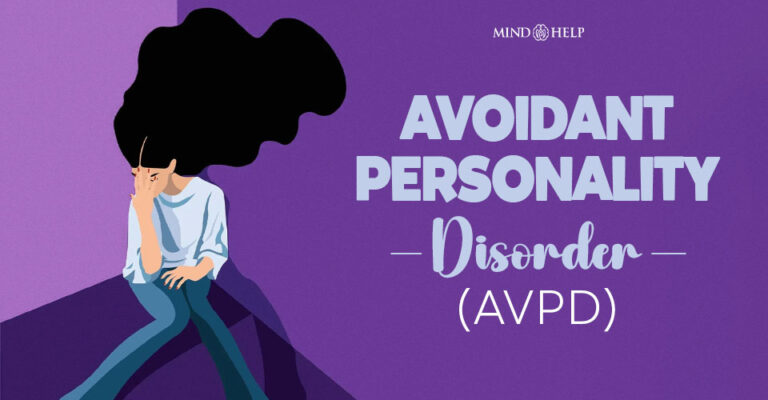Table of Contents
Self-monitoring is the practice of paying close attention to your own thoughts, emotions, and behavior. It’s a powerful tool for building self-awareness and understanding your personal patterns and habits.
In psychology, it’s sometimes also viewed as a personality trait, referring to how well someone can adjust their behavior to fit different social situations. Whether as a habit or a trait, self-monitoring helps you tune in to yourself and how you interact with the world around you.
What Is Self-Monitoring?
In psychology, self-monitoring, refers to a form of self-observation where a person consciously adjusts their behavior based on social cues. It’s closely linked to the goals of self-reflection and developing deeper self-awareness, helping individuals understand how they’re perceived and how they respond in different situations 1 Vago, D. R., & Silbersweig, D. A. (2012). Self-awareness, self-regulation, and self-transcendence (S-ART): a framework for understanding the neurobiological mechanisms of mindfulness. Frontiers in human neuroscience, 6, 296. https://doi.org/10.3389/fnhum.2012.00296 , identifying problematic behaviors and thought patterns, and making positive changes.
It involves systematically collecting and analyzing data 2 Epstein, R. M., Siegel, D. J., & Silberman, J. (2008). Self-monitoring in clinical practice: a challenge for medical educators. The Journal of continuing education in the health professions, 28(1), 5–13. https://doi.org/10.1002/chp.149 about oneself to identify behaviors or thoughts that may be problematic or interfering with one’s goals and to track progress over time.
The term “self-monitoring” was introduced in the 1970s by psychologist Mark Snyder 3 Snyder, M., & Gangestad, S. (1986). On the nature of self-monitoring: matters of assessment, matters of validity. Journal of personality and social psychology, 51(1), 125–139. https://doi.org/10.1037/0022-3514.51.1.125 . While his original concept focused on group self-presentation and social behavior 4 Klein, O., Snyder, M., & Livingston, R. W. (2004). Prejudice on the stage: self-monitoring and the public expression of group attitudes. The British journal of social psychology, 43(Pt 2), 299–314. https://doi.org/10.1348/0144666041501697 , the term has since been applied more broadly to include self-monitoring of mental health and physical behaviors as well as self-growth and goal-setting.

Read More About Goals Here
Signs Of Self-Monitoring
Research 5 Burke, L. E., Swigart, V., Warziski Turk, M., Derro, N., & Ewing, L. J. (2009). Experiences of self-monitoring: successes and struggles during treatment for weight loss. Qualitative health research, 19(6), 815–828. https://doi.org/10.1177/1049732309335395 attributes the common signs of this to the following:
- Saying things that are not true to gain attention or approval
- Performing or exaggerating behavior to seem entertaining to others
- Copying how others act to fit in
- Doubting yourself and relying on others for direction in social settings
- Seeking advice on what to say, wear, think, or do
- Frequently changing your opinions just to keep others happy
- Adapting your behavior based on who you’re around
- Altering the tone of your voice to match different social situations
- Unintentionally mirroring other people’s body language
- Ignoring your own instincts when making decisions or speaking up
Read More About Growth Mindset Here
Types Of Self-Monitoring
The two types 6 Wilde, M. H., & Garvin, S. (2007). A concept analysis of self-monitoring. Journal of advanced nursing, 57(3), 339–350. https://doi.org/10.1111/j.1365-2648.2006.04089.x of self-monitoring include:
1. Acquisitive self-monitoring
This behavior is aimed at gaining attention and approval in social settings. It often includes observing how others react and then adjusting or mimicking one’s own behavior to blend in, stand out, or gain recognition, status, or influence.
2. Protective self-monitoring
This form of self-monitoring is focused on avoiding disapproval and maintaining social acceptance. Known as protective self-monitoring, it often involves adapting behavior, beliefs, or attitudes to fit in with others, mimicking those around them, and steering clear of potential embarrassment or rejection in social situations.
Self-Monitoring vs Self-Talk
- Self-monitoring is a type of self-observation and restraint in which a person compels himself/herself to be guided by situational cues and social appropriateness. Whereas, self-talk 7 Geurts B. (2018). Making Sense of Self Talk. Review of philosophy and psychology, 9(2), 271–285. https://doi.org/10.1007/s13164-017-0375-y is an internal voice or dialogue influenced by inbuilt beliefs, unconscious biases, as well as social situations.
- Self-monitoring is sometimes a maladaptive behavior in uncomfortable situations, but self-talk is often recommended as a positive self-soothing tool to navigate stressful situations.
Self-Monitoring vs Self-Awareness
Self-monitoring refers to a form of self-observation and restraint in which a person compels himself/herself to be guided by situational cues and social appropriateness. Self-awareness 8 Dishon, N., Oldmeadow, J. A., Critchley, C., & Kaufman, J. (2017). The Effect of Trait Self-Awareness, Self-Reflection, and Perceptions of Choice Meaningfulness on Indicators of Social Identity within a Decision-Making Context. Frontiers in psychology, 8, 2034. https://doi.org/10.3389/fpsyg.2017.02034 , on the other hand, involves a person’s ability to perceive and understand the characteristics that make him/her a unique individual. These include gaining insights into his/her personality, actions, beliefs, emotions, and thoughts.
Mental Health Impact Of Self-Monitoring
The benefits of self-monitoring lie in fostering social cohesion. For people with introverted personalities, social anxiety, or adjustment issues, positive and well-regulated strategies provide opportunities to navigate social situations comfortably and communicate effectively.
They tend to be more sensitive to social cues and are more likely to be flexible in their self-presentation to fit different social situations. It also helps them to open up and form loving bonds with people of similar personalities or mindsets.
Maladaptive or negative self-monitoring, on the other hand, can lead to chronic self-doubt and self-esteem issues. People with such tendencies 9 Beiwinkel, T., Hey, S., Bock, O., & Rössler, W. (2017). Supportive Mental Health Self-Monitoring among Smartphone Users with Psychological Distress: Protocol for a Fully Mobile Randomized Controlled Trial. Frontiers in public health, 5, 249. https://doi.org/10.3389/fpubh.2017.00249 develop debilitating self-consciousness, anxiety, and tendencies to be extremely self-observant.
They tend to be very tense in social situations, which makes it difficult for them to communicate openly and interact freely with others. In some cases, it may enhance existing symptoms of depression, social anxiety, and sedentary and avoidant behavior.
Read More About Social Anxiety Here
Self-Monitoring Tools For Mental Health
In mental health, self-monitoring may involve tracking mood, anxiety, or symptoms of a mental health condition. There are many tools 10 Compernolle, S., DeSmet, A., Poppe, L., Crombez, G., De Bourdeaudhuij, I., Cardon, G., van der Ploeg, H. P., & Van Dyck, D. (2019). Effectiveness of interventions using self-monitoring to reduce sedentary behavior in adults: a systematic review and meta-analysis. The international journal of behavioral nutrition and physical activity, 16(1), 63. https://doi.org/10.1186/s12966-019-0824-3 related to this, ranging from traditional paper and pencil methods to modern digital apps and wearables. These include:
- Mood-tracking apps that track moods and identify behavioral triggers over time
- Thought recording worksheets used in cognitive-behavioral therapy (CBT) that identify negative patterns of thinking
- Sleep tracking devices to track sleep patterns and recommend sleep hygiene tips
- Stress-tracking apps that offer guided meditations, breathing exercises, and stress-management tools
- Symptom tracking apps that provide for the tracking of symptoms related to mental health conditions
- Journaling apps, ranging from traditional journaling to gratitude tracking, that help to improve mood and promote overall mental well-being.
Self-monitoring In Clinical Practice
Research reveals that positive self-monitoring and behavior changes (especially in therapeutic contexts) are closely related. It is an important technique used in clinical practice 11 Compernolle, S., DeSmet, A., Poppe, L., Crombez, G., De Bourdeaudhuij, I., Cardon, G., van der Ploeg, H. P., & Van Dyck, D. (2019). Effectiveness of interventions using self-monitoring to reduce sedentary behavior in adults: a systematic review and meta-analysis. The international journal of behavioral nutrition and physical activity, 16(1), 63. https://doi.org/10.1186/s12966-019-0824-3 to help individuals keep track of their own behaviors, thoughts, and emotions. It can be used to monitor progress and help identify areas of concern or improvement.
It can be used in many things such as cognitive-behavioral therapy (CBT) for anxiety, depression, and other conditions such as eating disorders, personality disorders etc. It is also used in the management of physical health conditions 12 Patel, M. L., Hopkins, C. M., Brooks, T. L., & Bennett, G. G. (2019). Comparing Self-Monitoring Strategies for Weight Loss in a Smartphone App: Randomized Controlled Trial. JMIR mHealth and uHealth, 7(2), e12209. https://doi.org/10.2196/12209 such as diabetes, hypertension, obesity, and chronic pain.
Self-monitoring also helps individuals identify triggers for problematic behaviors or symptoms, track progress over time, and provide a sense of control and empowerment. It can also help clinicians tailor treatment approaches accordingly and provide objective data for assessing treatment efficacy.
Read More About Cognitive Behavioral Therapy Here
How To Self-Monitor
Consider the following tips to self-monitor healthily:
- Set clear goals and identify the behaviors that you want to monitor and change over time.
- Use a reliable method of tracking 13 Page, E. J., Massey, A. S., Prado-Romero, P. N., & Albadawi, S. (2020). The Use of Self-Monitoring and Technology to Increase Physical Activity: A Review of the Literature. Perspectives on behavior science, 43(3), 501–514. https://doi.org/10.1007/s40614-020-00260-0 and stick to it. Consider using a paper diary, an app, or a wearable device.
- Be consistent and track your behaviors or symptoms regularly.
- Be honest, truthful, and objective when tracking your behaviors, even if it means admitting to setbacks or slip-ups.
- Focus on progress, not perfection. Celebrate your successes and acknowledge your progress, even if it’s small. Don’t get discouraged by setbacks and try harder to adjust your approach.
- Don’t become too obsessive in tracking your behaviors to point that it disrupts your daily life or causes undue stress.
- Share your results with a healthcare professional and discuss areas for improvement.
- Adjust your approach, if and when needed. If you’re not seeing the progress you’d like, adjust your approach or seek guidance from a healthcare professional.
- Respect your privacy and protect your tracking data from possible exploitation.
Takeaway
Self-monitoring for health and wellness can be a valuable tool for building self-awareness and supporting positive lifestyle changes.
However, it’s important to remember that it’s not a replacement for professional medical or mental health care. If you have serious concerns about your physical or emotional well-being, it’s always best to consult a qualified healthcare professional for proper guidance and support.
At A Glance
- Self-monitoring involves observing and tracking one’s own behavior, thoughts, and emotions to gain self-awareness and make positive changes.
- It can be used in various contexts, such as mental health, physical health, and personal development.
- It can be done using different methods, such as writing in a journal, using specialized apps, etc.
- Common examples include tracking food intake, physical activity, sleep patterns, symptoms of a mental health condition, and so forth.
- While it can be a helpful tool for making positive changes, it is not a great substitute for professional help to correct negative behavioral patterns.
Frequently Asked Questions (FAQs)
1. What is the importance of self-monitoring skills?
Self-monitoring is an important strategy that teaches us to self-assess our behavior and record the results.
2. What is the first step in self-monitoring?
The first step is identifying the target behavior and developing an adequate behavior plan.
3. What is a self-monitoring checklist?
A self-monitoring checklist is a list of behaviors, goals, or strategies aimed to help a person take control of his/her own behavior and monitor changes.
4. What is the problem with self-monitoring?
It can sometimes lead to the tendency of hypervigilance. This can make it difficult for people to relax or interact positively with others, thereby contributing to greater stress or anxiety for the person exercising self-monitoring.
5. Is self-monitoring effective?
Yes, it can lead to self-awareness about maladaptive behaviors and help a person self-regulate his/her behavior, thereby avoiding and coping with situations that often lead to failure.











